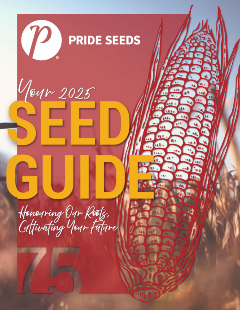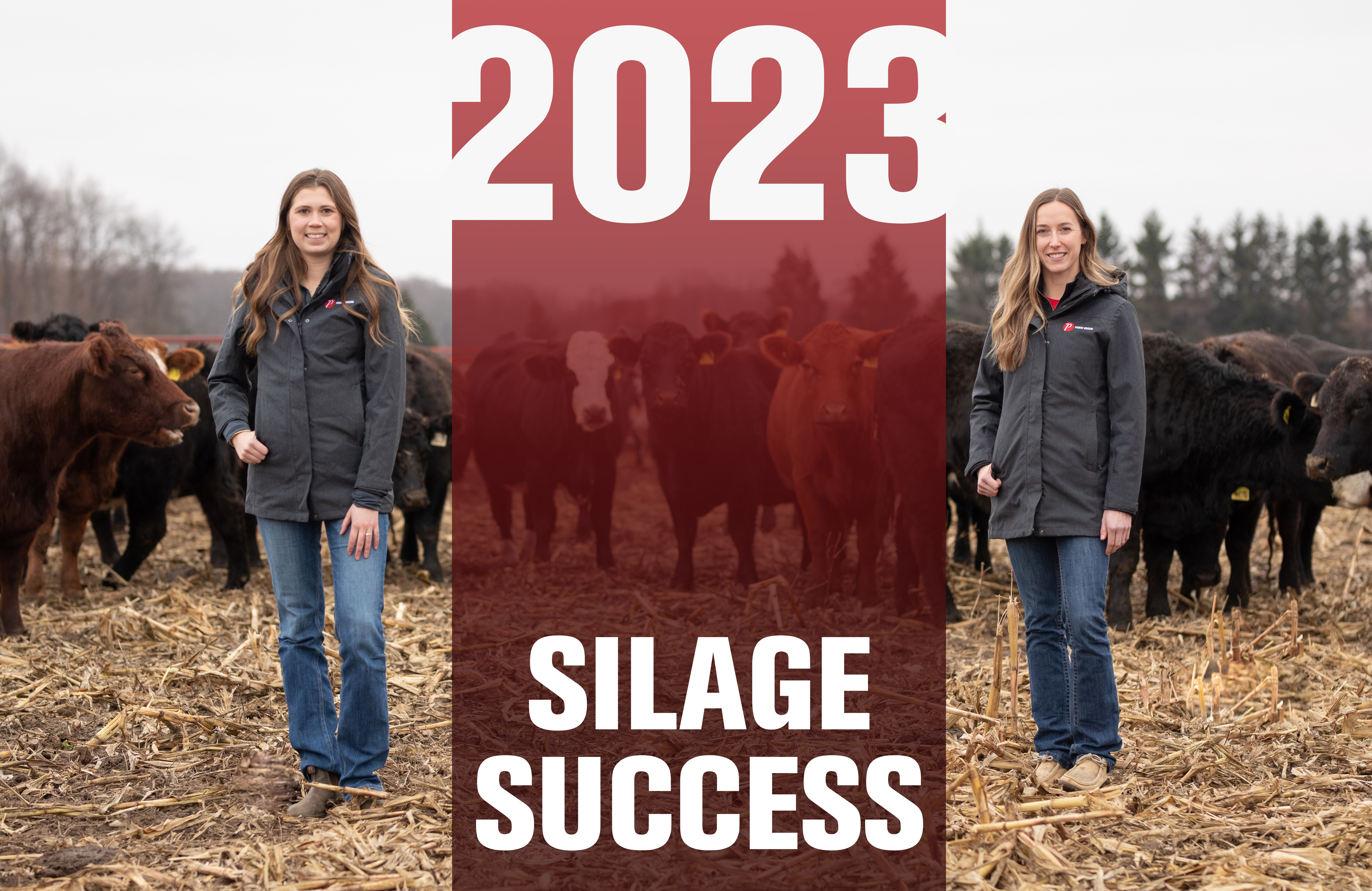___________________________________________________________________________________________________________________________________________

2024-2025 PRIDE Seeds Product GuideYou can find all of our products on the website, including supporting performance data and create your own personalized guide called My Guide. You can also download the digital version of our printed product guide which includes product comparison charts. |
Tonnage, Energy, and Silage Success: Optimizing Your Corn Crop

More and more western Canadian farmers are giving silage and grazing corn a try thanks to new shorter season hybrids that offer impressive yield – as much as 50% more silage yield than barley – as well as palatability and excellent digestibility. But, since corn is a somewhat higher-maintenance crop than most, getting the planting and in-crop fundamentals right is critical to success. Whether you’re brand new to corn or an experienced producer, here’s a quick pre-season primer for optimizing your corn crop:

“As a cattle farmer myself, corn has become an important crop on our farm because of its impressive yield. But, it does need to be handled right to get the most out of your investment,” says Breanne Rey, Market Development Agronomist with PRIDE Seeds. “Hybrid selection is an important step, but it doesn’t end there. Setting your corn crop up properly does require a bit of attention to detail and pre-planning.”
Start by prepping the seedbed right. Aim to plant into a firm seed bed to maximize seed-to-soil contact and allow nodal roots to develop well. Ensure residue is well-managed, as excess residue and no-till fields can result in emerging seedlings hair-pinning. On the other hand, excess tillage can result in crusting and compaction, so proper seedbed preparation isn’t one-solution-fits-all. Where possible, avoid tilling and planting in wet soils.
The target planting rate for silage corn can vary from 28,000 to 34,000 seeds per acre in most of Western Canada. Because the specific rate will depend on multiple factors – climate, soil type and productivity, resources available, planting date, hybrid characteristics, CHU region, end use and economics – ask for rate advice from a seed rep or agronomist.
If at all possible, plant using a planter rather than a seeder.
“In a nutshell, the goal is to have a weed-free picket fence stand: perfectly spaced, perfectly even,” says Rey. “Even planting equals consistent seed placement, consistent depth, and even emergence. The only way you’ll get that picket fence stand is with a planter,” says Rey.

Corn’s ideal planting depth is 1.5-2.5”, with 0.5” of moisture. Planting to this depth allows good seed-to-soil contact and good development of the nodal root system, which is critical to the resulting plant’s structural support as well as its nutrient and water uptake.
“When it’s dry, it can be tempting to plant deep to access as much moisture as possible. The problem with that is you’ll end up with delayed and uneven emergence, and leafing out underground. Even emergence is one of the most important factors in successful corn, so you really don’t want to plant too deep,” says Rey. “On the other hand, planting too shallow leads to poor root development and a crop that will tend to lodge. Ultimately, too shallow is even worse than too deep, but both are negative.”
Corn is very temperature sensitive. Aim to plant once the soil reaches 10°C at planting depth and temperature trend upwards for 48-hour post-planting. Planting into over-cool soils can lead to cold injury or, even worse, imbibitional chilling. Cold Injury occurs when there is a change in the soil temperature after the seed has imbibed water. Imbibitional chilling occurs when there is a drastic change in the water temperature during imbibition, most critically within 24 hours of planting.
“If you have cool soils and cool weather, it’s better leave the seed in the bag,” says Rey.
“You generally want to wait a little bit longer than you would for most cereal crops,” she adds. “The benefit of that is it does spread your planting window, allowing you to plant cereals early and corn fields later.”
A well-prepped seedbed, together with well-managed planting (planting the right rate, to the correct depth, at a good temperature and using a planter) gives the crop it’s best chance at even emergence. Corn is a poor competitor, even against other corn plants. Corn plants that emerge within 48 hours of each other are close enough in staging and development that they will not compete overly much, if at all. However, when plants emerge outside of that 48-hour time frame, late emerging plants tend to lag in staging and development compared to the plants that emerged in a timely fashion. Competition from the larger, first emerging plants will reduce the yield of the smaller, late emerging plants.
Expect emergence at 10 to 16 days post planting. In unfavorable emergence conditions, seeds may require up to 21 days to emerge.

Rey says, of all the management improvements a farmer could make, weed control is the lowest hanging fruit for improved corn production.
“We know corn is a poor competitor, so weed control should be first of mind, especially when the corn is small and can't compete.”
The VE/V1 through V6 (3 to 9 leaves) is corn’s critical weed free period (CWFP): the period during which weed competition will cause yield loss.
Weeds that grow later in the season likely won’t impact yield. However, weeds can slow the crop’s maturation because the plants don’t get the nutrients they need to mature; weeds can impact the crop’s harvestability, and weed seed dockage can cause problems in storage.
Weeds are also a big and very direct cost in nutrients:
“If weeds get to 4” tall, they can use up 50 to 80lbs more nitrogen per acre. Keeping your corn clean means the corn benefits from your fertilizer instead of just feeding weeds,” says Rey.
Overall, corn is a crop one does need to handle with more care than other crops. However, Rey says the payoff is worth it. “It is an investment. It’s a more expensive crop to grow but if you look at the tonnage and the energy that you get out of silage corn, there’s a really significant advantage over a crop like barley. We grow corn on our farm in Manitoba to feed our own cattle. I can tell you there’s nothing quite like a successful corn crop. It’s beautiful. And then when you chop it, it’s so nice to see the bunk filling up. That payoff is pretty awesome.”

PRIDE Seeds offers two distinct types of hybrid silage corn that suit Western Canadian acres. Effective Dual Purpose (EDP) hybrids are a high energy, high silage quality, maximum flexibility hybrid that suit harvesting as either grain or silage. Effective Digestible Fibre (EDF) hybrids are specifically bred for biomass, digestibility and palatability, making them ideal for maximum feed volume in forage and silage.
PRIDE Seeds is a Canadian company that offers global research and state-of-the-art breeding technology through its parent company, AgReliant Genetics. PRIDE Seeds’ single-minded and exclusive focus is seed development, specifically corn hybrids and soybean varieties.
PRIDE Seeds’ EDF and EDP hybrids are both sold under the PRIDE Total Ration Solutions (TRS) System. The TRS System identifies top-performance hybrids that deliver what matters most at harvest: yield, energy, digestibility, palatability, and overall nutritional value.
THE PRIDE SEEDS ADVANTAGE
Farming is one of the most demanding industries in the world, subject to a variety of factors such as time, weather, and global pressures. You know this every time you look out the window and think about the field in front of you. Growers and dealers deserve an advantage: The PRIDE Seed Advantage.
LEARN MORETHE PRIDE SEEDS ADVANTAGE
Every year PRIDE Seeds works hard to produce leading-edge products that enable success where it matters most, on your farm. Our dedicated team strives to provide sales expertise, agronomy support, quality production, and service tailored to meet your needs.
LEARN MORE
-7.png?sfvrsn=87920db3_3)

Leave a commentOrder by
Newest on top Oldest on top